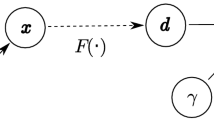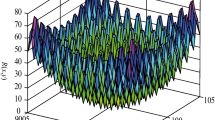Abstract
Generating one realization of a random permeability field that is consistent with observed pressure data and a known variogram model is not a difficult problem. If, however, one wants to investigate the uncertainty of reservior behavior, one must generate a large number of realizations and ensure that the distribution of realizations properly reflects the uncertainty in reservoir properties. The most widely used method for conditioning permeability fields to production data has been the method of simulated annealing, in which practitioners attempt to minimize the difference between the ’ ’true and simulated production data, and “true” and simulated variograms. Unfortunately, the meaning of the resulting realization is not clear and the method can be extremely slow. In this paper, we present an alternative approach to generating realizations that are conditional to pressure data, focusing on the distribution of realizations and on the efficiency of the method. Under certain conditions that can be verified easily, the Markov chain Monte Carlo method is known to produce states whose frequencies of appearance correspond to a given probability distribution, so we use this method to generate the realizations. To make the method more efficient, we perturb the states in such a way that the variogram is satisfied automatically and the pressure data are approximately matched at every step. These perturbations make use of sensitivity coefficients calculated from the reservoir simulator.
Similar content being viewed by others
References
Alabert, F., 1987, The practice of fast conditional simulations through the LU decomposition of the covariance matrix: Math. Geology, v. 19, no. 5, p. 369–386.
Chu, L., Reynolds, A. C., and Oliver, D. S., 1995, Computation of sensitivity coefficients for conditioning the permeability field to well-test pressure data: In Situ, v. 19, no. 2, p. 179–223.
Davis, M., 1987a, Generating large stochastic simulations—the matrix polynomial approximation method: Math. Geology, v. 19, no. 2, p. 99–107.
Davis, M., 1987b, Production of conditional simulations via the LU decomposition of the covariance matrix: Math. Geology, v. 19, no. 2, p. 91–98.
Deutsch, C. V., 1992, Annealing techniques applied to reservoir modeling and the integration of geological and engineering (well test) data: unpubl. doctoral dissertation, thesis, Stanford University, 325 p.
Deutsch, C. V., and Journel, A. G., 1992, GSLIB: Geostatistical Software Library and user’s guide: Oxford Univ. Press, New York, 340 p.
Dietrich, C. R., 1993, Computationally efficient generation of Gaussian conditional simulations over regular sample grids: Math. Geology, v. 25, no. 4, p. 439–451.
Dietrich, C. R., and Newsam, G. N., 1995, Efficient generation of conditional simulations by Chebyshev matrix polynomial approximations to the symmetric square root of the covariance matrix: Math. Geology, v. 27, no. 2, p. 207–228.
Farmer, C. L., 1992, Numerical rocks,in King, P. R., ed., Mathematics of oil recovery: Clarendon Press, Oxford, p. 437–447.
Feller, W., 1968, An introduction to probability theory and its applications, v. I (3rd ed.): John Wiley & Sons, New York, 509 p.
Geman, S., and Geman, D., 1984, Stochastic relaxation, Gibbs distributions, and Bayesian restoration of images: IEEE Trans. Pattern Analysis and Machine Intelligence, v. PAMI-6, no. 6, p. 721–741.
Gupta, A. D., 1992, Stochastic heterogeneity, dispersion, and field tracer response: unpubl. doctoral dissertation, Univ. Texas, Austin, 248 p.
Hammersley, J. M., and Handscomb, D. C., 1964, Monte Carlo methods: John Wiley & Sons, New York, 178 p.
Hastings, W. K., 1970, Monte Carlo sampling methods using Markov chains and their applications: Biometrika, v. 57, no. 1, p. 97–109.
Hegstad, B. K., Omre, H., Tjelmeland, H., and Tyler, K., 1993, Stochastic simulation and conditioning by annealing in reservoir description,in Armstrong, M., and Dowd, P. A., eds., Geostatistical simulation: Kluwer Acad. Publ., Dordrecht, The Netherlands, p. 43–55.
Journel, A. G., and Huijbregts, C. J., 1978, Mining geostatistics: Academic Press, New York, 600 p.
Koren, Z., Mosegaard, K., Landa, E., Thore, P., and Tarantula, A., 1991, Monte Carlo estimation and resolution analysis of seismic background velocities: Jour. Geophys. Res., v. 96, no. B12, p. 20,289–20,299.
Metropolis, N., Rosenbluth, A. W., Rosenbluth, M. N., Teller, A. H., and Teller, E., 1953, Equations of state calculations by fast computing machines: Jour. Chem. Physics, v. 21, no. 6, p. 1087–1092.
Neal, R. M., 1993, Probabilistic inference using Markov chain Monte Carlo methods: Tech. Rept. CRG-TR-93-1, Dept. Computer Science, Univ. Toronto, 140 p.
Oliver, D. S., 1994, The incorporation of transient pressure data into reservoir characterization: In Situ, v. 18, no. 3, p. 243–275.
Oliver, D. S., 1995, Moving averages for Gaussian simulation in two and three dimensions: Math. Geology, v. 27, no. 8, p. 939–960.
Oliver, D. S., 1996, Multiple realizations of the permeability field from well test data: Soc. Petrol. Eng. Jour., v. 1, no. 2, p. 145–154.
Ouenes, A., 1992, Application of simulated annealing to reservoir characterization and petrophysics inverse problems: unpubl. doctoral dissertation, New Mexico Tech., 205 p.
Ouenes, A., Bréfort, B., Muenier, G., and Dupéré, S., 1993, A new algorithm for automatic history matching: Application of simulated annealing method (SAM) to reservoir inverse modeling: unsolicited manuscript SPE 26297, 30 p.
Pérez, G., 1991, Stochastic conditional simulation for description of reservoir properties: unpubl. doctoral dissertation, Univ. Tulsa, 245 p.
Rao, C. R., 1965. Linear statistical inference and its applications. John Wiley & Sons, New York, 522 p.
Ripley, B. D., 1981, Spatial statistics: John Wiley & Sons, New York, 252 p.
Ripley, B. D., 1987, Stochastic simulation: John Wiley & Sons, New York, 237 p.
Sagar, R. K., Kelkar, B. G., and Thompson, L. G., 1993, Reservoir description by integration of well test data and spatial statistics,in Proc. 68th Ann. Tech. Conf. Exhibition: Soc. Petrol. Eng., p. 475–489.
Scheuer, E. M., and Stoller, D. S., 1962, On the generation of normal random vectors: Technometrics, v. 4, no. 2, p. 278–281.
Sen, M. K., Gupta, A. D., Stoffa, P. L., Lake, L. W., and Pope, G. A., 1992, Stochastic reservoir modeling using simulated annealing and genetic algorithm,in Proc. 67th Ann. Tech. Conf. Exhibition: Soc. Petrol. Eng., p. 939–950.
Srivastava, R. M., 1994, The interactive visualization of spatial uncertainty,in Proc. Univ. Tulsa Centennial Petroleum Engineering Symposium: Soc. Petrol. Eng., p. 87–95.
Tarantola, A., and Valette, B., 1982, Inverse problems = quest for information: Jour. Geophysics, v. 50, no. 3, p. 159–170.
Tierney, L., 1994, Markov chains for exploiting posterior distributions: Tech. Rept. 560 (revised), School of Statistics, Univ. Minnesota, 25 p.
Tjelmeland, H., Omre, H., and Hegstad, B. K., 1994, Sampling from Bayesian models in reservoir characterization: Tech. Rept. Statistics No. 2/1994, Univ. Trondheim, 15 p.
Author information
Authors and Affiliations
Corresponding author
Rights and permissions
About this article
Cite this article
Oliver, D.S., Cunha, L.B. & Reynolds, A.C. Markov chain Monte Carlo methods for conditioning a permeability field to pressure data. Math Geol 29, 61–91 (1997). https://doi.org/10.1007/BF02769620
Received:
Revised:
Issue Date:
DOI: https://doi.org/10.1007/BF02769620




